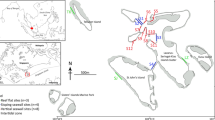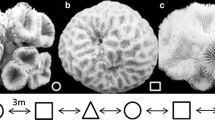Abstract
The motile crustacean cryptofauna of the hermatypic coralMadracis mirabilis (Duchassaing and Michelotti) was examined from three sites on reefs along the west coast of Barbados in 1985. In addition to site differences in degree of eutrophication, two distinct with-in-corallum habitats were recognized, based on differences in the growth form of the coral host. One form grows in isolated, hemispherical heads, with short, robust, widely separated branches covered by 50 to 80% live tissue. The second form occurs within large continuous beds of long, thin, tightly spaced branches tipped by 20 to 30% live tissue. Coral habitats consisting of small isolated heads support a crustacean fauna of high decapod and amphipod diversity, with numerous rare and site endemic species and an abundance of relatively large decapods and amphipods. The continuous beds favour a community of lower decapod and amphipod diversity, fewer rare and site endemic species and with an abundance of smaller sized isopods and copepods. It is suggested that spatial separation of branches and colonies as well as food availability associated with corallum morphology are factors influencing the variation in species abundance and faunal composition of the two habitats.
Similar content being viewed by others
Literature cited
Abele, L. G. (1976). Comparative species richness in fluctuating and constant environments: coral associated decapod crustaceans. Science, N.Y. 192: 461–463
Abele, L. G. (1984). Biogeography, colonization and experimental community structure of coral-associated crustaceans. In: Abele, L. G., Thistle, A.B. (eds.) Ecological communities: conceptual issues and evidence. Princeton University Press, Princeton p. 123–137
Abele, L. G., Patton, W. K. (1976). The size of coral heads and the community biology of associated decapod crustaceans. J. Biogeogr. 3: 35–47
Austin, A. D., Austin, S. A., Sale, P. F. (1980). Community structure of the fauna associated with the coralPocillopora damicornis (L.) on the Great Barrier Reef. Aust. J. mar. Freshwat. Res. 31: 163–174
Coles, S. L. (1980). Species diversity of decapods associated with living and dead reef coralPocillopora meandrina. Mar. Ecol Prog. Ser. 2: 281–291
Dardeau, M. (1984).Synalpheus shrimps (Crustacea: Decapoda: Alpheidae). I. The Gambrelloides group with a description of a new species. Mem. Hourglass Cruises, Florida Dept. Natural Resources, Mar. Res. Lab. 7: 1–125
Edwards, A, Emberton, H. (1980). Crustacea associated with the scleractinian coral,Stylophora pistillata (Esper.), in the Sudanese Red Sea. J. exp. mar. Biol. Ecol. 42: 225–240
Field, J. G., Clarke, K. R., Warwick, R. M. (1982). A practical strategy for analysing multispecies distribution patterns. Mar. Ecol. Prog. Ser. 8: 37–52
Gotelli, N. J., Abele, L. G. (1983). Community patterns of coral associated decapods. Mar. Ecol. Prog. Ser. 13: 131–139
Gotelli, N. J., Gilchrist, S. L., Abele, L. G. (1985). Population biology ofTrapezia spp. and other coral-associated decapods. Mar. Ecol. Prog. Ser. 89–98
Grassle, J. F. (1973). Variety in coral reef communities. In: Jones, O. A., Endean, R. (eds.) Biology and geology and coral reefs, vol. 2. Biology I. Academic Press, New York, p. 247–270
Huber, M. E., Coles, S. L. (1986). Resource utilization and competition among the five Hawaiian species ofTrapezia (Crustacea, Brachyura). Mar. Ecol. Prog. Ser. 30: 21–31
Hurlbert, S. H. (1971). The nonconcept of species diversity: a critique and alternative parameters. Ecology 52: 577–586
Hutchings, P. (1983). Cryptofaunal communities of coral reefs. In: Barnes, D. J. (ed.) Perspectives on coral reefs. Brian Closton, Manuka, Australia p. 200–208
Kensley, B. (1982). Anthuridae (Crustacea: Isopoda) of Carrie Bow Cay, Belize. Smithson Contr. mar. Sci. 12: 321–353
Kensley, B. (1984a). New marine Isopoda. Smithson. Contr. mar. Sci. 24: 1–81
Kensley, B. (1984b). The role of isopod crustaceans in the reef creast community at Carrie Bow Cay, Belize. Pubbl. Staz. zool. Napolie (I: Mar. Ecol.) 5: 29–44
Klumpp, D. W., McKinnon, A. D., Mundy, C. N. (1988). Motile cryptofauna of a coral reef: abundance, distribution and trophic potential. Mar. Ecol. Prog. Ser. 45: 95–108
Klumpp, D. W., Polunin, N. V. C. (1989). Partitioning among grazers of food resources within damselfish territories on a coral reef. J. exp. mar. Biol. Ecol. 125: 145–169
Knudsen, J. W. (1967).Trapezia andTetralia (Decapoda, Brachyura, Yanthidae) as obligate ectoparasites of pocilloporid and acroporid corals. Pacif. Sci. 21: 51–57
Kohn, A. J., Nybakken, J. W. (1975). Ecology ofConus on Eastern Indian Ocean fringing reefs: diversity of species and resources utilization. Mar. Biol. 29: 211–234
Lewis, J. B. (1960). The coral reefs and coral communities of Barbados, W. I. Can. J. Zool. 38: 1130–1145
Lewis, J. B. (1965). A preliminary description of some marine benthic communities from Barbados, West Indies. Can. J. Zool. 43: 1049–1074
Lewis, J. B., Axelsen, F. I., Goodbody, I., Page, C., Chislett, G. R. (1968). Comparative growth rates of some reef corals in the Caribbean. Mar. Sci. Manuscript Rept. McGill University, Montreal 10: 1–26
McCloskey, L. R. (1970). The dynamics of the community associated with a marine scleractinian coral. Int. Revue ges. Hydrobiol. 55: 13–81
Patton, W. K. (1973). Animal associates of living reef corals. In: Jones, O. A., Endean, R. (eds.) Biology and geology of coral reefs, vol. 3. Biology 2. Academic Press, New York, p. 1–36
Patton, W. K. (1974). Community structure among the animals inhabiting the coralPocillopora damicornis at Heron Island, Australia. In: Vernberg, W. B. (ed.) Symbiosis and the sea. University of South Carolina Press, Columbia, p. 219–243
Pielou, E. C. (1975). Ecological diversity. John Wiley & Sons, New York
Reed, J. K., Gore R. H., Scotto, L. E., Wilson, K. A. (1982). Community composition, structure, areal and trophic relationships of decapods associated with shallow- and deep-waterOculina varicosa coral reefs: Studies on decapod crustacea from the Indian River region of Florida, XXIV. Bull. mar. Sci. 32: 761–786
Reed, J. K., Mikkelsen, P. M. (1987). The molluscan community associated with the scleractinian coralOculina varicosa. Bull. mar. Sci. 40: 99–131
Sale, P. F., McWilliam, P. S., Anderson, D. T. (1978). Faunal relationships among the near-reef zooplankton at three locations on Heron Reef, Great Barrier Reef, and seasonal changes in this fauna. Mar. Biol. 49: 133–145
Snelgrove, P. V. R., Lewis, J. B. (1989). Response of a coral-associated crustacean community to eutrophication, Mar. Biol. 101: 249–257
Tomascik, T., Sander, F. (1985). Effects of eutrophication on reef-building corals I. Growth rates of the reef building coralMontastrea annularis. Mar. Biol. 87: 143–155
Tomascik, T., Sander, F. (1987). Effects of eutrophication on reef-building corals. II. Structure of scleractinian coral communities on fringing reefs, Barbados, West Indies. Mar. Biol. 94: 53–75
Vivien, M. L., Peyrot-Clausade, M. (1974). A comparative study of the feeding behaviour of three coral reef fishes (Holocentridae), with special reference to the Polychaeta of the reef cryptofauna as prey. Proc. 2nd int. Symp. coral Reefs. 1: 179–192 [Cameron, A. M. et al. (ed.) Great Barrier Reef Committee, Brisbane]
Zar, J. H. (1984). Biostatistical analysis. Prentice Hall Inc., Engelwood Cliffs
Author information
Authors and Affiliations
Additional information
Communicated by R. O'Dor, Halifax
Rights and permissions
About this article
Cite this article
Lewis, J.B., Snelgrove, P.V.R. Corallum morphology and composition of crustacean cryptofauna of the hermatypic coralMadracis mirabilis . Mar. Biol. 106, 267–272 (1990). https://doi.org/10.1007/BF01314810
Accepted:
Issue Date:
DOI: https://doi.org/10.1007/BF01314810




